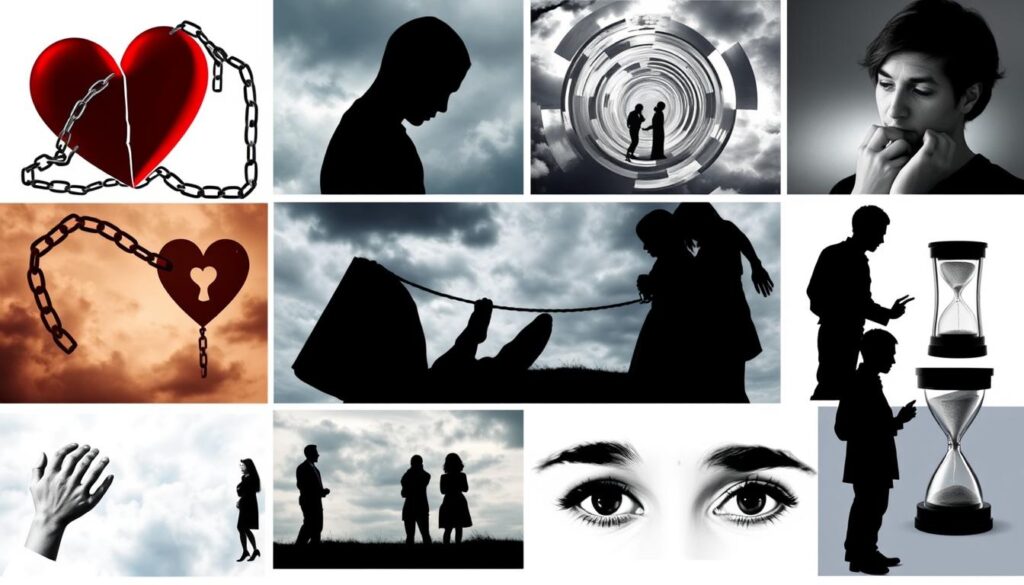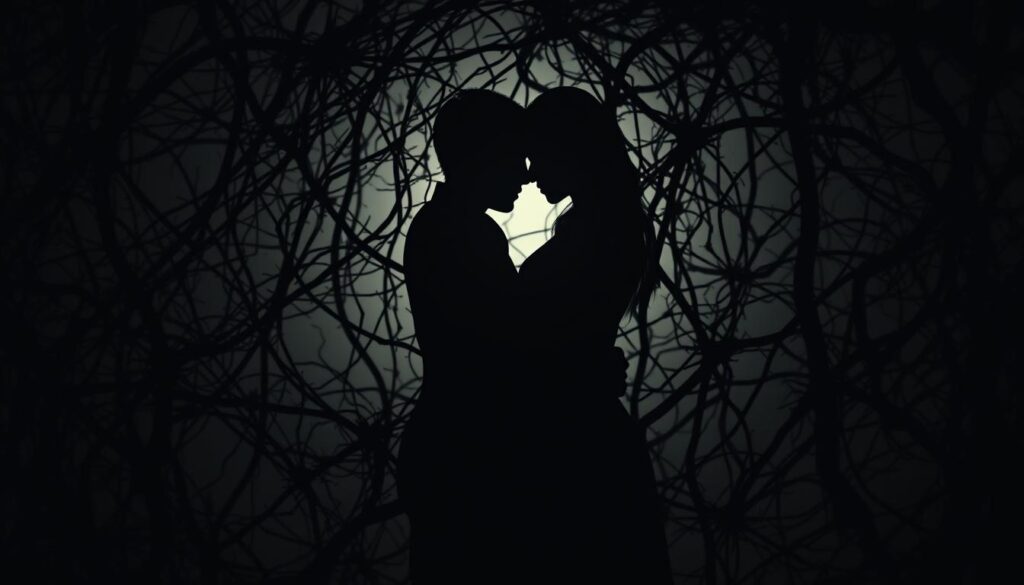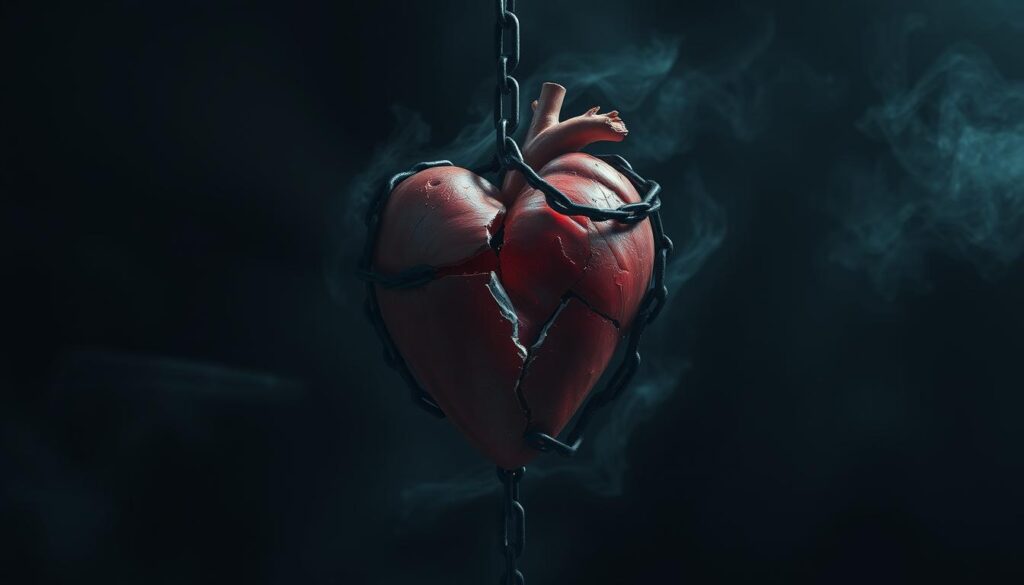10 Signs of Trauma Bonding occur when individuals form strong attachments to those who cause them harm. Around 90% of domestic abuse survivors report that their abusers seemed perfect most of the time. This can happen in romantic, friendship, or family relationships, often marked by emotional manipulation and toxic patterns. Recognizing the 10 signs of trauma bonding is crucial for breaking free from these destructive connections and reclaiming your life.

Spotting trauma bonding is hard, mainly for those in abusive situations. Only 10% of victims admit to relationship problems1. Yet, by spotting the signs and symptoms, like emotional manipulation and toxic relationships, you can start healing and moving on.
Table of Contents
Understanding Trauma Bonding: The Basics
10 Signs of Trauma Bonding are crucial to recognize in order to escape harmful relationships. This bond develops through a cycle of abuse mixed with intermittent moments of positivity, fostering codependency. Victims often struggle to see these signs due to the confusing nature of the cycle, which keeps them emotionally entangled.
Knowing the psychology of trauma bonding is vital. Trauma bonding happens when someone is abused and then shown love. This mix can cause emotional numbness and even thoughts of suicide4.
What Creates a Trauma Bond?
A trauma bond forms when someone is abused and then praised. This mix of feelings, like shame and love, can confuse the victim4. About 70% of those in abusive situations don’t see the trauma bonding signs. They often blame themselves for the abuse4.
The Psychology Behind Trauma Bonding
The psychology of trauma bonding is complex. It involves codependency and signs of psychological abuse4. Knowing these factors helps victims recognize trauma bonding and leave abusive relationships.
The Impact of Trauma Bonding on Mental Health
Trauma bonding in relationships can harm mental health a lot. It can lead to more anxiety, depression, and PTSD5. The cycle of abuse and control is very damaging. It’s key to know the signs of trauma bonding and get help.
Signs of trauma bonding include feeling overly dependent, isolated, and scared to leave. Around 25% to 35% of people in abusive situations experience trauma bonding. To break free from these bonds, it’s essential to prioritize your mental health. Seek professional help, join support groups, and focus on self-care to rebuild your sense of independence and well-being.
Here are some ways to start breaking free from trauma bonds:
- Recognize the signs of trauma bonding and acknowledge the abuse
- Seek professional help and support
- Practice self-care and prioritize mental health

Breaking free from trauma bonds takes time, patience, and support. By understanding trauma bonding’s effects and seeking help, you can start healing and recovering5.
| Statistical Data | Percentage |
|---|---|
| Individuals in toxic relationships reporting trauma bonding | 70% |
| Children raised in abusive environments developing codependency | 50% |
| Individuals experiencing narcissistic abuse recognizing trauma bonding signs | 85% |
Recognizing the 10 Signs of Trauma Bonding in Relationships
To escape a toxic relationship, knowing the 10 signs of trauma bonding is key. These signs can be physical, emotional, or behavioral. Spotting these signs is the first step to healing.
Signs like feeling ashamed or guilty, hiding or lying about abuse, and being always on guard are common7. Spotting these signs is crucial for recognizing toxic relationships and getting help. About 90% of the time, survivors see their abusers as “wonderful,” with only 10% facing challenges8.
Understanding trauma bonding dynamics is the first step to freedom. Knowing the signs of emotional manipulation and the cycle of abuse helps. Studies show that 75% of people who learn about trauma bonding can break free8.
Being aware of physical, emotional, and behavioral signs of trauma bonding is vital. This knowledge helps identify toxic relationships and start the healing journey.
The Cycle of Abuse in Trauma Bonds
Being in a relationship with someone who is emotionally or physically abusive can be tough. It’s hard to see the signs of trauma bonding. This bond often comes with a cycle of abuse that harms your mental and emotional health. It starts with love bombing, where the abuser showers you with love, then moves to devaluation, where they criticize and belittle you9.
Some common traits of toxic bonds include:
- Intense emotional highs and lows
- Feelings of isolation and disconnection from friends and family
- Difficulty making decisions or setting boundaries
About 70% of people in abusive relationships say they feel trapped, showing how strong trauma bonding can be9. Also, studies show that those with lower economic status are 50% more likely to experience trauma bonding than those with more financial stability6.
It’s key to spot the signs of psychological abuse, like gaslighting, emotional manipulation, and isolation. Knowing the cycle of abuse and the signs of toxic bonds can help you start to break free and take back your life9.

Breaking the Chains: First Steps to Freedom
Breaking free from trauma bonds needs self-awareness, support, and professional help. Knowing the signs of trauma bonding is key. It helps people seek help when needed. Understanding the role of self-awareness, support, and professional help is vital. It helps start the journey out of abuse and towards recovery.
Some important steps to break free from trauma bonds include:
- Seeking professional help from a therapist or counselor
- Building a support network of trusted friends and family members
- Practicing self-care and self-compassion
It’s crucial to know the toxic bond characteristics that trap people in abuse. Understanding these can help start the journey to freedom. Tips for trauma bond recovery, like seeking support and self-care, are very helpful10.
Research shows that breaking trauma bonds can feel like withdrawal from addiction11. This shows how important professional help and support are in this process.
Starting the journey to freedom is the first step towards healing. It’s a tough path, but with the right support, people can overcome abuse. They can then live a healthier, happier life12.
| Step | Action | Result |
|---|---|---|
| 1 | Seek professional help | Begin to understand the trauma bond and develop a plan for recovery |
| 2 | Build a support network | Gain a sense of community and connection, helping to break the isolation of the trauma bond |
| 3 | Practice self-care and self-compassion | Develop a greater sense of self-awareness and self-worth, helping to break the trauma bond |
The Role of Childhood Trauma in Bonding Patterns
Childhood trauma deeply affects how we bond with others. It can lead to codependency and trauma bonding. Research shows that those who faced trauma as kids are 80% more likely to get into trauma bonding as adults13. This is because early trauma and family patterns can shape our unhealthy bonding habits.
Signs of trauma bonding include intense emotions, a need to please, and fear of being left. These signs can point to psychological abuse, which harms our mental health. Studies show that about 70% of those in trauma bonding situations develop PTSD13.
It’s crucial to understand how childhood trauma shapes our bonds. If you see codependency or trauma bonding, seek help. Knowing about childhood trauma’s impact is the first step to freedom. Some important facts include:
- 90% of abusive relationships involve manipulation, like love bombing and gaslighting13
- 80% of trauma bond victims are people-pleasers, often putting others first13
- 70% of those in therapy for trauma bonding can move to healthier relationships13

Recognizing trauma bonding signs and getting help is the first step to healing. By understanding childhood trauma’s effects and getting support, you can move away from unhealthy bonds. This opens the door to more fulfilling relationships.
Identifying Your Trauma Bond Triggers
10 Signs of Trauma Bonding include recognizing toxic relationships that form in family dynamics, romantic partnerships, cults, sex trafficking, and gangs. It’s vital to spot the signs of psychological abuse, as it affects over 60% of individuals trapped in trauma bonds. Understanding these signs can help you break free and begin the healing process.
People in trauma bonds often feel helpless, a feeling shared by 70-90% in abusive situations14. These bonds often form after a violent or abusive event, happening in about 75% of abusive relationships14. To find your triggers, look at these signs:
- Feeling emotionally tied to your partner
- Being isolated from friends and family
- Having low self-esteem
- Trying too hard to get approval
About 60% of those in abusive relationships have low self-esteem, making it hard to leave14. Isolation is a big issue, with 70% of victims cut off from loved ones by their abuser14. Knowing your triggers is the first step to freedom and healing15.
Building a Support System for Recovery
Surrounding yourself with supportive people is key when trying to break free from trauma bonds. This includes professionals like therapists and support groups. It also includes friends and family who offer emotional support. Research shows that about 70% of people in trauma bonds don’t see their relationship as abusive16.
This makes it crucial to get help and support. A support system gives you a safe place to talk about your feelings and experiences. This is very helpful when dealing with the toxic nature of these bonds.
Some important parts of a support system are:
- Professional resources, such as therapists or counselors
- Support groups, either in-person or online
- Friends and family members who can provide emotional support
Building a support system is the first step towards reclaiming your life. It helps you break free from the cycle of abuse. Research shows that survivors may need up to 7 tries to leave an abusive relationship successfully17.
With the right support and resources, you can increase your chances of a successful recovery. You can also learn effective ways to deal with trauma bonds.

Remember, recovery from trauma bonding is a journey. It’s important to be patient and kind to yourself. By having a supportive network and seeking professional help, you can start healing and rebuilding your life.
| Support System Component | Benefits |
|---|---|
| Professional Resources | Expert guidance and support |
| Support Groups | Community and connection with others who have experienced similar situations |
| Friends and Family | Emotional support and a sense of belonging |
Setting Boundaries After Trauma Bonding
Breaking free from trauma bonding in relationships starts with setting boundaries. It’s key to spot psychological abuse signs and how they strengthen the bond. About 71% of people in emotionally abusive relationships form trauma bonds18. Knowing these signs and protecting yourself is vital.
To start breaking free from trauma bonds, setting clear boundaries is crucial. It’s hard, but you must remember you deserve respect and kindness. Up to 70% of those in abusive relationships feel deeply attached to their abuser19. Setting boundaries helps you escape this cycle and begin healing.
Here are some ways to set boundaries:
- Communicate your needs and expectations clearly
- Establish consequences for abusive behavior
- Prioritize self-care and seek support from friends, family, or a therapist
Setting boundaries isn’t selfish; it’s about caring for yourself. It’s the first step towards healing and moving past trauma bonding.
The Science of Trauma Bond Recovery
It’s key to know the science behind healing from trauma bonds. Tips for recovery often talk about the brain’s response to trauma bonding. This can make the healing journey tough20. It can take 5 to 7 years for some to fully break free20.
Understanding the unhealthy patterns in toxic bonds is hard. But, knowing these patterns and getting help is the first step. It’s a journey that needs a full approach, including professional help and support from loved ones21.

- About 1 in 4 women and 1 in 9 men face severe physical violence from a partner20.
- Up to 80% of women in abusive situations may form a trauma bond with their abuser20.
- Victims may go through 7 to 10 cycles of trauma bonding before trying to leave20.
By grasping the science of trauma bond recovery and getting help, people can beat the challenges. They can start their healing journey22.
Self-Care Strategies During Recovery
Recovering from a trauma bond needs a full plan that focuses on self-care. This helps both the body and mind feel better. By using trauma bond recovery tips, people can start to leave the abuse behind and heal. It’s key to know the toxic bond characteristics that led to the trauma bond and find ways to beat them2.
Some good self-care steps include:
- Doing physical activities like yoga or meditation to relax and reduce stress
- Practicing emotional health, like journaling or therapy, to handle feelings and learn to cope
- Looking for support from loved ones or groups to build strong, positive relationships
Studies show that about 75% of people with strong support networks are less likely to form trauma bonds6. By adding these self-care steps to daily life, people can start tobreak free from trauma bonds and rebuild their lives.
Remember, healing from a trauma bond is a long journey. It needs patience, kindness to oneself, and support. By focusing on self-care and getting help when needed, people can beat the toxic bond characteristics that held them back. They can then start their healing and freedom journey1.
| Self-Care Strategy | Benefits |
|---|---|
| Physical activity | Reduces stress and anxiety, promotes relaxation |
| Emotional health practices | Processes emotions, develops coping mechanisms |
| Social support | Builds positive relationships, reduces feelings of isolation |
When to Seek Professional Help
It’s key to know the signs of trauma bonding to break free from trauma bonds. Studies show about 70% of people with substance use disorders have faced past trauma23. This shows why getting professional help is vital for dealing with toxic bond characteristics and finding good trauma bond recovery tips.
Getting help is a big step towards healing from trauma bonding. Understanding the trauma bond characteristics and getting help is the first move towards taking back your life. Professional therapy for trauma bonds helps survivors heal and become resilient24. They use different therapies like Cognitive-Behavioral Therapy (CBT), EMDR, and Attachment-Based Therapy24.
It’s crucial to know the value of seeking professional help and to care for your mental health. Getting help lets people start to break free from the cycle of abuse and move towards healing. In the U.S., over 29% of women have been abused by an intimate partner25. Trauma bonds can happen in many relationships, like with romantic partners, parents, coworkers, and friends25.

Research links trauma bonding to mental health problems like anxiety and depression25. This shows the need for special therapy. By spotting the signs of trauma bonding and getting help, people can start their journey to recovery and find good trauma bond recovery tips.
Creating Your Personal Safety Plan
Breaking free from trauma bonds starts with a personal safety plan. This plan should list emergency contacts, safe places, and resources for support. Knowing the signs of trauma bonding, like emotional instability and abuse, is key to a good plan26.
A safety plan helps set boundaries and focus on your well-being. Research shows setting boundaries is vital for healing from trauma. Having a trusted support system also plays a big role in recovery27. Important parts of a safety plan include:
- Identifying emergency contacts, like a trusted friend or family member
- Finding a safe and secure place to live
- Planning to leave an abusive relationship, including a safe place to stay and financial help
It’s also crucial to recognize trauma bonding signs, like feeling trapped or isolated. Seeking help is important. Understanding abuse signs and taking steps to break free can start the healing process28.
| Resource | Description |
|---|---|
| National Domestic Violence Support Hotline | A 24/7 hotline that provides support and resources for individuals experiencing domestic violence |
| Childhelp National Child Abuse Hotline | A 24/7 hotline that provides support and resources for individuals experiencing child abuse |
Remember, breaking free from trauma bonds is a journey that takes time and support. With a safety plan and help when needed, you can start to reclaim your life and heal from trauma26.
Rebuilding Trust After Trauma Bonding
Rebuilding trust is key to overcoming trauma bonding. It’s about breaking free from abuse and starting recovery. Getting professional help and focusing on mental health is crucial. About 90% of domestic abuse survivors saw their abusers as “perfect” most of the time1. This shows the need for trauma bond recovery tips and ways to break free from trauma bonds.
Some important steps for rebuilding trust include:
- Identifying and challenging negative thought patterns
- Practicing self-care and self-compassion
- Seeking support from trusted friends, family, or a therapist
It’s also vital to understand thetoxic bond characteristicslike emotional manipulation or gaslighting. Up to 70% of those with trauma bonds may feel empathy or bond with their abuser2.

By understanding trauma bonding’s complexity and the trust rebuilding challenges, individuals can start healing. About 85% of victims lose self-worth due to trauma bonding2. With the right support and strategies, they can heal and regain trust in themselves.
| Strategy | Description |
|---|---|
| Seeking professional help | Working with a therapist or counselor to address underlying issues and develop coping strategies |
| Practicing self-care | Engaging in activities that promote physical and emotional well-being, such as exercise or meditation |
| Building a support network | Surrounding oneself with trusted friends, family, or support groups |
Conclusion: Your Journey to Freedom and Healing
Your journey to freedom and healing shows your strength and resilience. By recognizing the29 signs of psychological abuse and seeking help, you’ve bravely started your journey. Healing is a journey of self-discovery and growth30.
As you keep setting boundaries29, build a support system, and focus on your mental health, you’re taking back control of your life29. The road to recovery is tough, but with the right resources and determination, you can overcome the29 cycle of abuse and trauma bonding.
Embrace self-care30 and surround yourself with supportive people who can29 help you heal. Seek professional help when needed30. Trust in your ability to navigate this journey towards a brighter, more empowered future.
Your story is a testament to the human spirit’s resilience. Through your dedication and commitment to your own29 healing, you’re not only transforming your life but also inspiring others who have walked a similar path30. Embrace the freedom that comes with breaking free from trauma bonding. Let this be the start of a new chapter filled with self-love29 and endless possibilities.
FAQ
What is trauma bonding?
Trauma bonding is when someone forms a strong emotional tie to their abuser, even though they’re being abused. It’s hard to see and break free from this bond.
What are the signs of trauma bonding?
Signs include physical and emotional symptoms, and certain behaviors. Knowing these signs helps in recognizing and dealing with trauma bonding.
How does trauma bonding impact mental health?
It can lead to anxiety, depression, and PTSD. Taking care of your mental health is key, and seeking help is important.
What is the cycle of abuse in trauma bonds?
The cycle has three parts: love bombing, devaluation, and reconciliation. Knowing this cycle helps in recognizing and escaping abuse.
How can childhood trauma contribute to trauma bonding?
Childhood trauma can shape unhealthy bonding patterns, like codependency and trauma bonding. Recognizing this is vital for healing.
How can I identify my trauma bond triggers?
Finding out what triggers your trauma bond is a big step towards healing. Knowing these triggers helps in managing them.
Why is building a support system important in trauma bond recovery?
A strong support system is essential for recovery. It includes professional help, support groups, and friends and family. This support helps in healing and breaking free.
How do I set boundaries after a trauma bond?
Setting clear boundaries is crucial for recovery. It means setting healthy limits and expectations in your life and relationships. This helps you feel safe and in control.
What is the science behind trauma bond recovery?
Recovery involves understanding how trauma bonding affects the brain and the healing process. Knowing this science helps in navigating the path to healing.
When should I seek professional help for trauma bond recovery?
Professional help is often needed for trauma bond recovery. Mental health experts provide the support and guidance needed to heal and rebuild a healthy life.
Source Links
- 10 Trauma Bonding Signs – How to Recognize a Trauma Bond – Attachment Project – https://www.attachmentproject.com/psychology/trauma-bonding/10-signs/
- 11 Unusual Signs Of Trauma Bonding Most People Miss – https://www.yourtango.com/heartbreak/signs-trauma-bonding-most-people-miss
- How to Break a Trauma Bond: Stages, Signs, and Healing – https://mentallystrong.com/how-to-break-a-trauma-bond/
- Trauma Bonding Isn’t Bonding Over Shared Trauma—It’s More Like Stockholm Syndrome – https://www.verywellmind.com/trauma-bonding-5207136
- Understanding the Impact of Trauma Bonds in Our Lives – https://www.psychologytoday.com/intl/blog/understanding-ptsd/202205/understanding-the-impact-of-trauma-bonds-in-our-lives
- Online Counselling | Online Therapy| Marriage Counsellors | TalktoAngel – https://www.talktoangel.com/blog/early-signs-of-trauma-bonding
- What Is Trauma Bonding? Signs to Watch Out For – Grow Therapy – https://growtherapy.com/blog/what-is-trauma-bonding/
- Toxic Trauma Bonding: Recognizing and Breaking Free – Mental Health Hotline – https://mentalhealthhotline.org/toxic-trauma-bonding/
- 10 Signs of trauma bonding – https://www.psychmechanics.com/10-signs-of-trauma-bonding/
- Healing from Dissociation: Understanding Bonding and Baby Steps to Connection – https://drannaback.com/2024/10/12/healing-from-dissociation-understanding-bonding-and-baby-steps-to-connection/
- 8 Ways to Heal Attachment Wounds & Abandonment Fears – https://medium.com/@SPClusterB/8-ways-to-heal-attachment-wounds-abandonment-fears-6df101b89930
- How to Attract Someone Who Loves You & Puts You First – https://medium.com/@SPClusterB/how-to-attract-someone-who-loves-you-puts-you-first-81ab14ef64dd
- What are the 7 Stages of Trauma Bonding? | Get Support Today – https://icarusbehavioralhealthnevada.com/7-stages-of-trauma-bonding/
- 10 Signs of Trauma Bonding – https://betterme.world/articles/10-signs-of-trauma-bonding/
- Trauma Bonding: What It Is and How to Heal – https://www.verywellhealth.com/trauma-bonding-5210779
- Trauma Bonding: Definition, Stages, & Recovery | Sandstone Care – https://www.sandstonecare.com/blog/trauma-bonding/
- Trauma Bonding: Signs, Stages & Recovery – Valley Hospital Phoenix – https://valleyhospital-phoenix.com/uncategorized/trauma-bonding-signs-stages-recovery/
- Understanding Trauma Bonding and How to Break Free – https://themendproject.com/trauma-bonding/
- Understanding Trauma Bonds: 10 Tips for Overcoming It for Mental Liberation – https://www.onlymyhealth.com/what-is-trauma-bond-how-to-recognise-and-break-it-1709283789
- 7 Stages of Trauma Bonding in a Relationship and How to Deal – https://www.marriage.com/advice/mental-health/seven-stages-of-trauma-bonding/
- Trauma Bonding Presentation 2024 – https://www.canconferenceuofm.org/wp-content/uploads/Trauma-Bonding.pdf
- How to Tell if You’re in a Trauma Bonding Relationship—and What to Do About It – https://www.wellandgood.com/trauma-bonding-relationship/
- Trauma Bonding And Addiction – https://www.addictioncenter.com/addiction/trauma-bonding/
- Effective Therapies for Healing from Trauma Bond Relationships – https://www.brightpoint-md.com/health-conditions/effective-therapies-for-healing-from-trauma-bond-relationships/
- What Is A Trauma Bond Relationship? — Anchor Therapy, LLC – https://www.anchortherapy.org/blog/what-is-a-trauma-bond-relationship-nyc-therapist
- Trauma bonding: How to identify it & 4 strategies for healing – https://www.rula.com/blog/trauma-bonding/
- From Victim to Survivor: Empowering Steps to Break the Cycle of Trauma Bonds – https://concept.paloaltou.edu/resources/business-of-practice-blog/break-the-cycle-of-trauma-bonds
- Trauma-Bonded vs. Healthy Relationships — &Rise – https://www.womenrisechicago.org/blog/trauma-bonded-vs-healthy-relationships
- Reclaiming Your Power: The Real Journey of Healing from CPTSD and Trauma – https://drannaback.com/2024/08/23/reclaiming-your-power-the-real-journey-of-healing-from-cptsd-and-trauma/
- EMDR and Attachment-Focused Trauma Therapy for Adults – https://www.susanquinn.net/post/emdr-and-attachment-focused-trauma-therapy-for-adults


